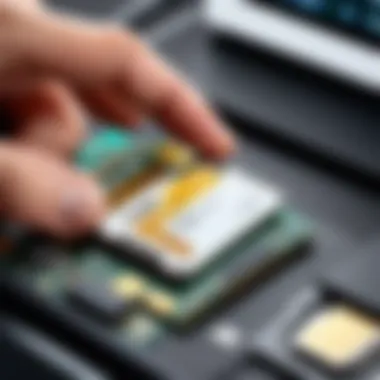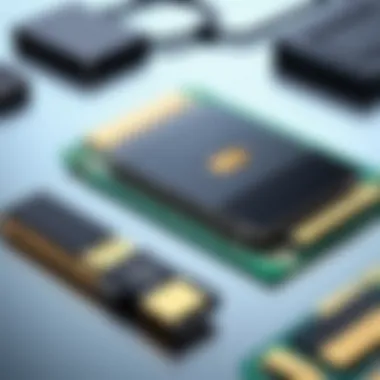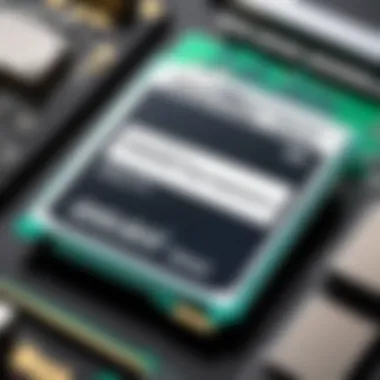Ultimate Guide to Upgrading to 512GB Memory Cards


Intro
The shift to using a 512GB memory card involves various considerations, especially for those who might be unsure about the details. This guide aims to clarify each relevant aspect, ensuring that users can navigate through the complexities involved in making this important switch. Understanding memory cards, specifically those with 512GB capacity, holds significant relevance in today’s tech-driven world. Not only do they enhance storage capabilities, but they also influence the efficiency of devices—be it a smartphone, camera, or gaming console.
From compatibility to data transfer methods, this guide provides an informed approach oriented toward tech enthusiasts as well as casual consumers. The goal is to articulate key elements that will assist in making a successful transition, all presented without bogging down in unnecessary technical jargon.
Product Overview
Key Features
When discussing 512GB memory cards, it is important to highlight several key features. These storage devices typically offer:
- Large storage capacity: Ideal for high-resolution photos, videos, and extensive data.
- Speed classes: Class 10 or UHS-I/UHS-II ratings ensuring fast read/write speeds.
- Durable construction: Many brands focus on making cards resistant to harsh conditions like water, temperature, or magnetic fields.
Technical Specifications
The technical specs often guide choice when considering a memory card. Relevant specifications for a 512GB card include:
- Form Factor: Usually available as SDXC or microSDXC cards.
- Interface: UHS-I or UHS-II, impacting transfer speeds.
- Dimensions: Standard SD card dimensions or micro variants for portable devices.
Pricing Information
The cost of 512GB memory cards varies according to brand and features:
- Basic cards: Starting around $50.
- High-performance cards: Range from $100 to $300, depending on speed and durability.
Performance Analysis
Benchmark Results
Benchmark tests are crucial for assessing performance. Many 512GB cards can achieve read speeds of up to 300 MB/s, while write speeds may reach around 200 MB/s depending on the card's classification.
Real-World Use Cases
Real-world performance often differs slightly from benchmarks. For instance, when using a card in a DSLR or 4K camera, you might find:
- Fast burst shooting: Cards with higher speeds allow for rapid image capture.
- 4K video recording: Ensure card supports high bit rates and consistent write speeds.
Comparison with Competitors
In the market, several brands stand out. Popular contenders in this space are SanDisk, Samsung, Lexar, and Kingston. Each brand offers varying benefits that appeal to different use cases and price points.
Installation and Setup
Required Tools and Components
Minimal tools are needed for installation. Simply a device with an appropriate slot is sufficient, alongside the card itself. An adapter may be necessary for devices that require a different format.
Step-by-Step Installation Guide
- Insert the memory card into the device slot.
- Ensure it clicks securely into place.
- Format the card through device settings to prepare it for use.
Troubleshooting Common Issues
Should you encounter problems, consider:
- Checking for loose connections.
- Verifying the compatibility of the card with your device.
- Reformatting the card if it fails to be recognized.
Pros and Cons
Advantages of the Product
- Substantial storage allows for extensive data collection.
- High-speed options minimize lag in data retrieval and saving.
Disadvantages or Limitations
- Higher cost compared to lower capacity cards.
- Mismanagement can lead to data corruption.


Who It’s Best Suited For
The 512GB memory card is excellent for photographers, gamers, and anyone needing substantial storage for high-quality files.
Final Thoughts
Summary of Key Points
This guide provides a detailed overview of switching to a 512GB memory card, covering compatibility, performance, and setup processes.
Recommendations for Potential Buyers
Before purchasing, assess your usage needs. High-performance cards are often a wise choice for professionals, whereas casual users might find mid-range options satisfactory.
Future of the Technology or Product Line
As technology progresses, memory card capacities are likely to continue increasing. Future cards may offer faster speeds and larger storage, making them more beneficial for demanding applications.
Investing in a reliable 512GB memory card can significantly enhance your storage experience.
Foreword to Memory Cards
Memory cards play a vital role in modern digital life. They serve as compact storage devices for various types of data, from photos to applications. As digital content becomes more demanding, understanding memory cards is increasingly important. The focus here is on transitioning to a 512GB memory card, a popular choice for many users.
Choosing the right memory card impacts performance. For photographers, videographers and gamers, speed and capacity are key factors. Thus, knowing the differences in memory card types enhances user experience.
Understanding Memory Card Types
Memory cards come in several formats. The most common types include SD cards, microSD cards, CompactFlash and others. Each type has its own specifications, which influence compatibility with devices.
- SD (Secure Digital) cards: Used mainly in cameras and laptops.
- microSD cards: Smaller variant, widely used in smartphones, drones, and some cameras.
- CompactFlash cards: Typically found in professional cameras due to their high capacity and speed.
- CFast cards: Evolving from CompactFlash to support faster data transfers in professional settings.
Understanding these types is crucial for selecting the right card for specific devices and tasks.
Popular Uses of Memory Cards
Memory cards are versatile and widely used across various fields:
- Photography: Storing high-resolution images and videos necessitates large storage capacity.
- Video Recording: High-definition video files demand fast and reliable storage solutions.
- Gaming: Consoles and handheld devices often rely on memory cards for saving games and downloadable content.
- Smartphones and Tablets: They are essential for enhancing storage capacity in devices that do not have expandable options.
These applications underscore the need for a memory card with substantial capacity, such as 512GB, to accommodate increasing data storage demands. Evaluating how and where you plan to use the memory card helps streamline the selection process.
Why Choose a 512GB Memory Card?
Choosing the right memory card is crucial in today's data-driven world. A 512GB memory card stands out due to its balance of capacity, performance, and versatility. This section will explore the specific elements that make a 512GB memory card a worthy choice for various applications, such as photography, gaming, and general data storage.
Storage Capacity and Flexibility
The primary advantage of a 512GB memory card is its ample storage capacity. This size allows users to store thousands of photos, videos, and documents without the constant need to transfer files. For photographers, this means fewer interruptions during a shoot. Videographers appreciate the ability to record in high resolutions without worrying about running out of space. In casual use, a full library of music or podcasts is easily accessible.
Furthermore, flexibility is an important consideration. A 512GB card caters to a wide range of devices, including smartphones, professional cameras, and gaming consoles. This versatility means that one card can serve multiple purposes, eliminating the need for several different storage cards.
Comparing 512GB with Other Capacities
When it comes to memory cards, comparing capacities is essential. 512GB offers a substantial increase from the more common 256GB or 128GB options. Here are some comparisons to consider:
- 256GB: Suitable for users with moderate data needs, but can fill up quickly, especially with high-quality videos and images.
- 128GB: Often insufficient for serious work or graphic-heavy games. Users might find themselves managing files frequently.
- 1TB: Offers more space, but may be overkill for casual users and tends to be more expensive.
Choosing 512GB strikes a practical balance between storage and cost. It offers enough space for extensive data without going overboard. This makes it a smart investment for those looking for reliability and flexibility in their storage solutions.
Key Point: A 512GB memory card provides significant storage while maintaining usability across multiple devices.
Compatibility Considerations
Understanding compatibility is crucial when switching to a 512GB memory card. The device you intend to use the card with determines how well the card will perform. An incompatible card might not work at all or could lead to suboptimal performance.
Device Compatibility for 512GB Cards


When considering a 512GB memory card, it is essential to check if your device supports this capacity. Many modern devices, such as cameras, smartphones, and gaming consoles, accept larger cards, but older models may only support smaller ones. It's advisable to consult your device's manual or the manufacturer's website for specific compatibility details.
For instance, devices utilizing SD or microSD formats often have different maximum capacities. The SD standard originally limited maximum capacity to 2GB, while SDHC expanded it to 32GB, and SDXC covers up to 2TB. Therefore, a device supporting SDXC can handle a 512GB card, while one only supporting SD or SDHC cannot.
In addition, the interface plays a significant role. Some devices require a specific speed class for optimal performance. Make sure your device documentation specifies support for newer standards like UHS-I or UHS-II, which are essential for faster transfer rates.
File System Requirements
Next, the file system format is another critical factor when adopting a new 512GB card. Most portability-focused devices operate on FAT32 or exFAT file systems. FAT32, while widely compatible, has a maximum single file size limit of 4GB. If your files exceed this limit, you must format the card to exFAT. This system supports storage sizes greater than 32GB and is more suitable for larger files.
To format a memory card appropriately, you can use built-in functionality on most operating systems. Ensure you back up any data before you format, as this process deletes everything on the card.
Reading and Writing Speeds
The performance of a memory card includes its reading and writing speeds. This is especially important for tasks such as video recording or transferring large files. The speed classes help define minimum write speed capabilities. For example, a Class 10 card guarantees a minimum write speed of 10MB/s, whereas a UHS-I card may exceed that significantly.
When using a 512GB card, a higher speed class is advantageous for efficient performance. If your device supports it, opting for UHS-II cards offers faster speeds compared to standard UHS-I cards. It is also worth noting that the actual performance may vary based on the devices used, as not all devices take full advantage of higher-speed ratings.
Understanding compatibility ensures not only that your 512GB card works with your device but also that you can maximize its performance.
Data Migration When Switching Memory Cards
Data migration is a critical aspect of switching memory cards, particularly when transitioning to a 512GB option. This process ensures that all data is carefully transferred to the new card while maintaining accessibility and organization. Proper data migration minimizes the risk of data loss and makes the switch seamless. Understanding the important steps involved in the migration process can protect your valuable files, photos, and documents.
Preparing for Data Transfer
Before transferring data, it is crucial to prepare effectively. Start by creating a backup of all data stored on the old memory card. This can be done by copying files to a computer or cloud storage service. Having a backup safeguards against unforeseen issues that could arise during the transfer process. Once the backup is secure, format the new 512GB memory card. Formatting the card will ensure it's ready for data input and can optimize performance. Proper organization of files before transferring can make it easier to manage the data on the new card.
Preparing in this way takes minimal time but can prevent potential headaches during transition.
Available Transfer Methods
There are several methods available for transferring data from one memory card to another. Here are some commonly used methods:
- Direct Card Reader Transfer: Use a card reader connected to a computer. Simply insert both the old and new cards into the reader. This method offers fast transfer speeds.
- Mobile Device Transfer: If transferring between mobile devices, use built-in file-sharing apps or cloud-based services to move files directly.
- Computer Transfer: Insert the old card into the computer, copy files, and then insert the new card to paste them. This method is simple but requires a computer.
Choosing the right method depends on the resources available and the volume of data that needs transferring. Evaluate each method based on speed and convenience according to your specific needs.
Ensuring Data Integrity
Data integrity is paramount during the migration process. To ensure that the files are not corrupted or lost, follow these practices:
- Verify data before and after transfer. Regularly compare the files on the old card with those on the new card. Make sure the transferred files open correctly.
- Avoid interrupting the transfer process. Sudden disconnections or power loss can lead to incomplete transfers.
- Safely eject both memory cards from the computer or device once the transfer is complete. This prevents potential data corruption.
Monitoring these elements can significantly increase the reliability of migrated data. Taking a meticulous approach can make a considerable difference, especially when dealing with large files or sensitive data.
Remember: No matter which method you use, consistent checks will help ensure that your data remains intact.
By focusing on these aspects of data migration when switching to a 512GB memory card, you can facilitate a smooth transition while safeguarding your important files. A well-prepared approach allows users to enjoy the benefits of increased storage without the stress of misplaced or lost data.
Performance Factors of 512GB Memory Cards
When considering a 512GB memory card, performance is crucial. The speed and reliability of a memory card impact its functionality in various devices. Performance factors can determine how effectively you can save and access your data. For photographers, videographers, and gamers, knowing the right specifications is essential in ensuring smooth operation.
Speed Class Ratings Explained
Speed class ratings serve as a guideline on the write speed of memory cards. These ratings help consumers to understand how fast data can be written to the card, which is especially important in high-data tasks such as video recording or rapid photography.
The Speed Class categories include:
- Class 2: Minimum write speed of 2 MB/s.
- Class 4: Minimum write speed of 4 MB/s.
- Class 6: Minimum write speed of 6 MB/s.
- Class 10: Minimum write speed of 10 MB/s.
For a 512GB card, a Class 10 rating is often the minimum recommended, particularly for those who intend to use the card for recording full HD videos or shooting in burst mode. Without the proper speed class, the device may struggle, leading to dropped frames or corrupted files.
For any user demanding high performance, selecting a card with a suitable speed class is vital.
UHS Speed Classes Overview


The UHS (Ultra High Speed) ratings add another layer to speed classification. UHS ratings are especially relevant for users in need of rapid write speeds for advanced photographic and video tasks. UHS designations include:
- UHS-I: Minimum write speed of 10 MB/s. It is commonly used in devices that only need moderate speed.
- UHS-II: Minimum write speed of 30 MB/s. This is ideal for professional cameras that require more substantial data capacity for video and high-resolution images.
For a 512GB card to deliver optimal results, the faster the UHS class, the better it can handle extensive tasks. High UHS ratings support faster data transfer, which is beneficial when transferring large files to or from your devices.
Choosing a 512GB memory card with the right speed classes will enhance your storage experience, ultimately boosting your productivity and enjoyment.
Potential Challenges in Switching Memory Cards
Switching memory cards, particularly when upgrading to a 512GB option, is not always straightforward. There are several potential challenges that users may encounter during this process. Understanding these challenges can help mitigate risks and ensure a smooth transition. This section will detail key issues users must consider when they switch memory cards, highlighting the importance of preparation and awareness.
Compatibility Issues
Compatibility is one of the most significant aspects to watch for when switching from an older memory card to a new 512GB model. Not all devices can support higher-capacity cards. For instance, some older cameras, smartphones, or tablets may only recognize memory cards up to 256GB. Before making a purchase, check the device's specifications and manual to confirm support for 512GB cards.
Another point to consider is the format of the card. Different devices may require different file systems, such as FAT32 or exFAT. Ensure the card is formatted correctly before installation in the device. If not, users may have to reformat the card, which could lead to data loss if not handled prudently.
Data Loss Risks
Data loss is a pressing concern while switching memory cards. During the transfer of data, files can become corrupt or accidentally deleted. Users should always create backups of important files before beginning the migration process. This entails duplicating data on a second device or storage solution, such as an external hard drive or cloud storage.
Additionally, unintentional ejections of the card during the transfer can lead to incomplete data migration. To avoid this, it is crucial to ensure that the data transfer process is completed before removing the card from the device. Users should employ reliable software tools for data migration whenever possible, as they often provide additional security features.
Failure to Recognize New Card
Another challenge that can occur is the failure of the device to recognize the new memory card. This can be frustrating, especially after investing in a high-capacity card intended for enhanced performance. Common reasons for this issue include incompatibility between the card format and the device, or a faulty card itself.
If a new card is not recognized, first check for physical issues such as dirt in the card slot or misalignment. Sometimes, simply re-inserting the card can resolve the problem. If these steps do not work, it may require formatting the card or consulting the device's documentation for troubleshooting tips. In some cases, it may be necessary to seek out help from the manufacturer's customer support.
Remember: Always ensure your device supports the new card format before making a purchase. This knowledge can save you time and frustration in future.
Maintaining Your 512GB Memory Card
Maintaining your 512GB memory card is crucial to ensure its longevity and performance. A well-maintained card will help you avoid data loss and performance issues. Regular care and attention to detail can make a significant difference in the reliability of this important storage device. The following sections will cover best practices for care and how to identify signs of wear that can affect your card's effectiveness.
Best Practices for Care
To keep your 512GB memory card in optimal condition, consider the following best practices:
- Proper Insertion and Removal: Always insert and remove the memory card properly. Avoid forcing it into a slot. Use gentle pressure when inserting or ejecting the card to prevent damage.
- Regular Backups: Make frequent backups of your data. This will not only secure your information but also reduce the stress on the memory card. In case something goes wrong, having a backup readily available is essential.
- Storage Environment: Store your memory card in a cool, dry place. Extreme temperatures and humidity can cause physical damage. Using a protective case can offer added security when the card is not in use.
- Safe Ejecting: Always use the safe eject option in your device before removing the card. This prevents data corruption and ensures all files are properly closed.
- Cleaning the Card: Periodically clean the metal contacts of the card gently with a soft, lint-free cloth. Dirt and grime can prevent proper contact with devices and affect performance. Make sure the card is not connected to any device while cleaning.
Reminder: Regular maintenance is key to avoiding data loss and maximizing the lifespan of your memory card. Following these best practices can save time and money in the long run.
Identifying Signs of Wear
Recognizing signs of wear on your memory card is essential for maintaining data integrity and performance. Here are some indications that could signal potential issues:
- Unusual Error Messages: Frequent error messages during data transfer can indicate that the memory card is beginning to fail. Be alert to any discrepancies that arise during use.
- Slow Data Transfer Speeds: If you notice slower transfer speeds than usual, it may suggest wear or damage. Check the specifications to see if they are still being met.
- Physical Damage: Inspect the card for any visible signs of damage, such as cracks or bends. Physical damage can affect how it functions with devices.
- Inconsistent Device Recognition: If your devices fail to recognize the memory card consistently, this could mean a problem with the card.
- Data Corruption: Finding files that are missing or corrupted can be an indicator of a failing card. Always keep backups to prevent potential losses.
Taking the time to maintain your 512GB memory card and identifying signs of wear can not only preserve its functionality but also protect your valuable data. Adopting these habits ensures a smoother experience as you utilize your memory card across various devices.
Ending: Making Informed Decisions
When it comes to selecting a memory card, especially a 512GB option, informed decisions can make a significant difference. This process involves understanding various factors such as compatibility, performance, and individual needs. A careful evaluation of these elements ensures that the card will not only meet your storage requirements but also function optimally with your devices.
Assessing your specific usage scenarios is critical. This includes considering whether the card will be used for high-resolution photography, video recording, gaming, or general file storage. Different activities demand different speed and capacity requirements. This section serves to solidify your knowledge and inform your choices.
Assessing Your Needs
Evaluating your needs is paramount in simplifying the selection process. Ask yourself what you primarily use your memory card for. If you are a photographer, high write speeds and reliability are essential. Cameras often require quick data transfer rates to prevent dropped frames, especially when shooting in burst mode. In contrast, casual users may prioritize storage capacity without needing the highest performance.
Here are some key questions to consider:
- What type of files will you store? Large video files require more space than standard image files.
- How often do you transfer data? Frequent transfers necessitate faster read and write speeds.
- Are you using it with multiple devices? Ensure compatibility across the devices you plan to use.
By reflecting on these elements, you can efficiently narrow down your options, ensuring that your selected memory card aligns with your requirements.
Tips for Selecting the Right Card
Selecting the appropriate memory card should not be an arbitrary decision. Several pointers can aid in making a more educated choice:
- Check Compatibility: Always verify that the memory card is compatible with your device. Refer to user manuals for specifications.
- Choose the Right Speed Class: Depending on your needs, consider speed class ratings. If you’re recording 4K video, a UHS Speed Class 3 card is ideal.
- Evaluate Brand Reputation: Well-known brands typically provide higher quality and better reliability. Options like SanDisk, Lexar, and Samsung tend to perform exceptionally well.
- Consider Future Needs: Choose a card with a bit more capacity than your current needs. This helps avoid the hassle of upgrading sooner than expected.
- Warranty and Support: Look for cards with a warranty. Good customer support can be invaluable if any issues arise.
By following these guidelines, you can select a 512GB memory card that best meets your personal or professional needs.



